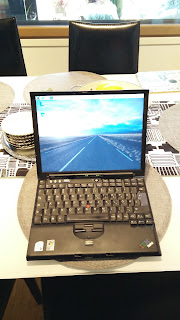I got a chance to make friends with a PC from year 1985. So please welcome a laptop Bondwell Model 8. It has an Intel 80C88 processor running at 4.77 MHz and 512 KB of RAM. The screen has a resolution of 640 x 200 with 80 x 25 characters. In addition there is a 720 KB built-in floppy drive. You can check the rest of the specifications here: http://www.computinghistory.org.uk/det/6731/Bondwell-Model-8/
Bondwell Model 8
My Bondwell was delivered without a power supply. After some searching I found a power made by Nokia. Polarity, voltage, amperes and the plug - they all matched.
Reuse of an old power supply makes me happy
After firing up it took a moment for the laptop to count all RAM memory (512 KB!). Bondwell Model 8 was originally delivered with MS-DOS 2.11 boot floppy. There was not a such floppy inside the drive. Now what? I had to prepare a one.
WinImage is an app for Windows which writes DOS floppy images on floppies. If you need an image search many places since not all images work. After some browsing a MS-DOS 3.20 image (720 KB) was downloaded and was waiting for writing on a floppy.
A floppy turned from 1.44 MB into 720 KB
with a piece of tape
WinImage is easy to use once you know what to do. Follow these steps:
Open the image; File, Open. Make sure the floppy is in the drive and recognized by WinImage. Then choose Disk, Format and write disk.
A floppy image ready for writing
Writing of the image going on
USB floppy drive TEAC FD-05PUB
It was time to try the boot floppy. And it worked like a charm. Finnish keyboard layout is missing but who cares (you know those funny characters å, ä and ö...).
Using Bondwell Model 8 laptop was like the experience I had in the beginning of the 90's with Toshiba T1100. They both need a boot floppy. My Toshiba had a card hard drive (~2.5 MB) and MS-DOS 3.3 in ROM. Back then Toshiba T1100 was more advanced than Bondwell Model 8. However the owners didn't think of the specs that much. PCs (and laptops in particular) were so expensive you were lucky if you had one!








